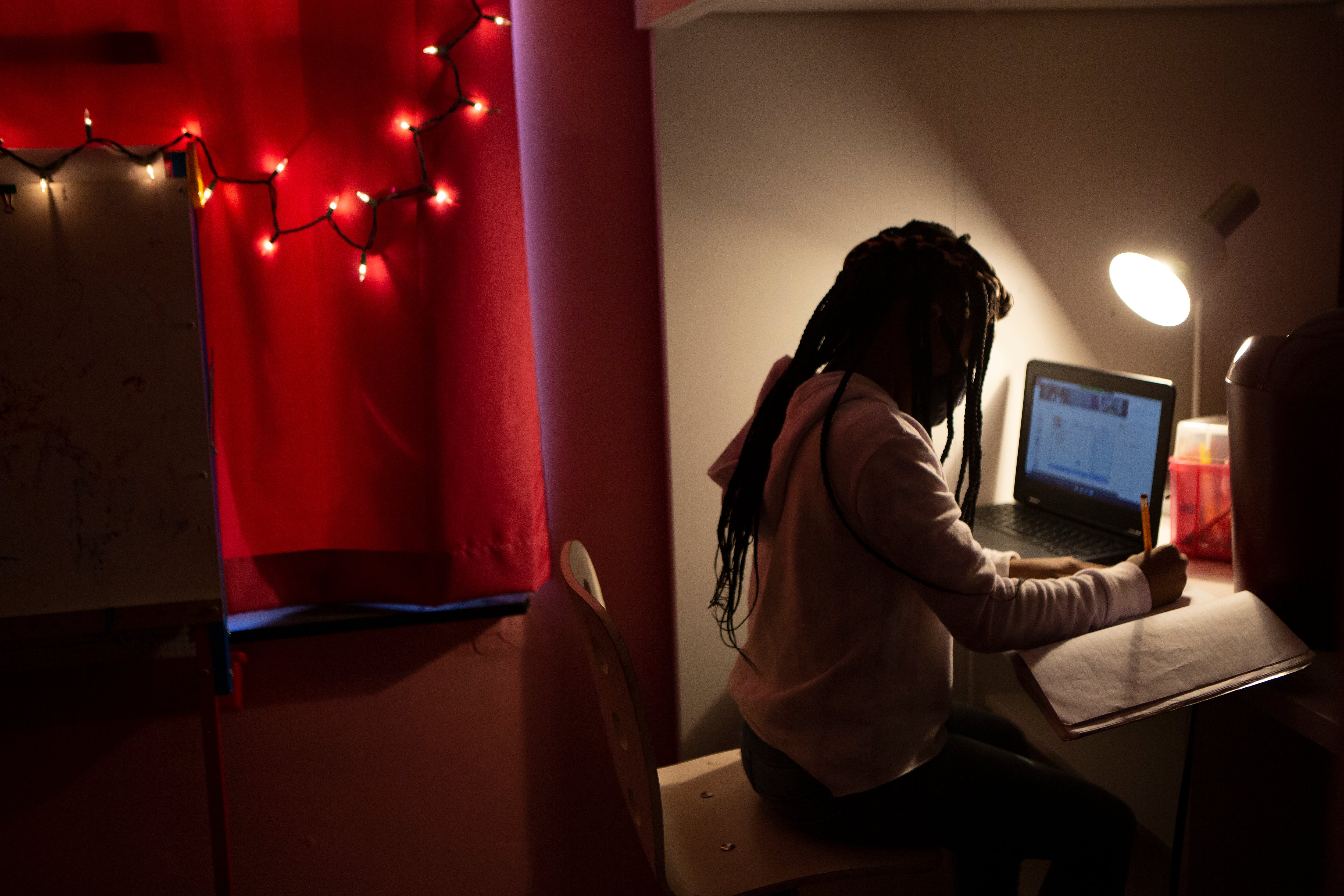Virtual learning has been part of student life since the pandemic began in 2020. So when the Detroit district elected to open its own virtual school this year, Victoria Haynesworth decided it was a no-brainer to enroll her son.
“My son’s safety ... that was the moving force for me,” she said of her 14-year-old. “It had everything to do with the pandemic from A to Z. I knew that I needed something else besides in person.”
Ahead of this school year, school officials were banking on the virtual option becoming a permanent fixture for students who thrive in the online space. The district also hoped the virtual school would accommodate families’ health and safety concerns.
But as the academic year unfolds, even as the Detroit Public Schools Community District has committed to improving the program, families are finding that being enrolled in the district’s virtual school hasn’t always been easy.
Developing the virtual school has been a goal for Detroit Superintendent Nikolai Vitti, who plans to spend $5.1 million in federal COVID relief money to hire more staff. That would address parent concerns from throughout the school year that virtual classrooms are too full and some classes are not staffed on too many days. Other parents have complained that the program hasn’t provided enough services for their children with special education needs.
Most recently Vitti said the district is considering limiting enrollment to grades 4-12 in the 2022-23 school year, as school officials have questioned whether the virtual school is the right space for early literacy in pre-kindergarten to third grade.
Accounting for the varied needs of virtual school families
Aliya Moore enrolled her 11-year-old daughter into the district’s virtual program due to safety concerns. Moore said her daughter has not had a consistent social studies teacher or substitute since late October. In her math class, her instructor left for the last weeks of the semester to take care of her mother who contracted COVID.
“The rest of her classes, she doesn’t really have a solid elective. Her schedule says art, but there has been no art,” she added.
Detroit is not an outlier. Parents in school districts across the country have complained about inadequate staffing, few learning accommodations, and a lack of extracurriculars for remote students.
Bree Dusseault, an analyst at the Center on Reinventing Public Education, says there was a trend this fall among larger school districts who created permanent remote learning options as “a function of responding to parent demands and trying to recapture enrollment … not necessarily as a longer term vision for what a good remote learning environment could look like for kids.”
“We know that there are examples of high quality remote learning, but a good remote learning environment needs to be done with intentionality and based on research, and what we’ve learned around best practices,” she said.
Michael Barbour, a professor at Touro University California who studies virtual instruction, said districts could better improve their remote options by developing multiple learning models that can accommodate the differing needs of students enrolled in virtual learning.
“You could easily set up a program where at least you have two options where you could have students that learn 100% at home or you could have students that learn 100% online, but do it in a classroom setting where there’s a facilitator or teacher that’s there to help them … sort of muddle their way through some of the content,” Barbour said.
After an increase in interest from families in the weeks leading up to the start of school, the Detroit school district sought to hire more teachers and staff for the virtual school. Fall enrollment began at 1,900 students but ballooned to 2,100 students going into the spring semester.
An estimated 260 students have opted out of the district’s required weekly COVID testing, which means they will be transferred to the virtual school. One hundred thirty objecting students from kindergarten to grade 5 were transferred to the virtual school by the week of Feb. 28, with high school students projected to move over by the end of this week.
Haynesworth has talked to her fair share of parents who were on the fence about enrolling their children in the virtual school in the fall and ahead of the second semester.
“I think a lot of them are really thinking about safety, as well as wanting to know that everything that needs to be implemented is going to be implemented through virtual school,” she said.
‘It isn’t perfect … however it is effective’
DPSCD Virtual School was not the first school of choice for Francheska Gonzalez’s son, Luis, but she says he’s learned to adapt to the remote environment after she opted not to send him into a classroom because he has problems with asthma.
“Attending remotely takes more discipline; however I feel my son is best supported in this environment,” Gonzalez said. “It has made him more self-sufficient, organized and disciplined. It isn’t perfect and flawless, however it is effective.”
But some parents differ. Marquita Andrews’ son, who is dyslexic and has learning accommodations, struggled with the district’s virtual school this past semester.
In an in-person classroom setting, Andrews said her son would be in a resource room all day and receive audio-visual lessons to help him with reading, as well as timely reminders from a resource to take his required medication. Most virtual school days, he’s not reminded to take his medication. Some days he gets frustrated and logs off. Recently he told his mom that he’d rather study for a high school equivalency exam.
“He was excited when the school year started but at this point, he’s over it,” said Andrews. “He’s expressed to me, “I’m tired of asking for help and I’m not getting it.”
Vitti said that the district has tried to be clear that it can only accommodate students with learning disabilities who have IEPs that have been reviewed ahead of virtual school enrollment.
“Some of the educational, behavioral, and physical needs of particular students cannot be met in a virtual learning environment,” he said.
School districts across the country have had to wrestle with the challenges of offering complete services to students with individualized education plans, known as IEPs, that require complex accommodations.
“I think that remote schools can start to get into a gray zone of how much they can provide those services,” Dussealt said, adding that districts could theoretically allow remote students who need in-person accommodations to access services at a central location.
The road ahead for virtual schools
Joe Friedhoff, vice president of online learning non-profit Michigan Virtual Learning Research Institute, says that the challenges school districts have faced so far with virtual learning are not damning, and do not define remote instruction as a whole.
“What the pandemic brought about is a form of virtual learning, but it’s really a lot more like an emergency learning,” Friedhoff said. “What kids got in schools and parents got exposed to was as best as we could do with very little training and very little preparation in most cases.”
In Detroit, some parents have complained that their students don’t have access to the same courses or extracurriculars as in-person students do. Vitti said the district is “exploring the possibility of” advanced courses and more electives in the future. For the time being, the school will focus on its core classes and support for exceptional student education, or ESE, students. Other resources such as after-school tutoring, he added, may be offered if teachers are willing to work after long days of screen time.
“Our goal was to get the school off the ground without knowing how many students actually would enroll,” Vitti said. “As enrollment settles then we will expand programming if student numbers support the expansion.”
Friedhoff said there’s a long road ahead for school district leaders to design and implement high quality online learning options that balance the flexibility of remote instruction with the academic standards of in-person learning.
Moore’s biggest concern is about the learning gaps she perceives her daughter will have coming out of this school year. The district recently offered her a seat on an advisory council, which she hopes she can parlay into ensuring more services are offered.
“I’m here for results,” she said. “If we are going to be a part of this, and to really lay the platform for how this virtual setting is going to be permanently, I’m with that.”
Ethan Bakuli is a reporter for Chalkbeat Detroit covering Detroit Public Schools Community District. Contact Ethan at ebakuli@chalkbeat.org.
Editor’s note: This story has been updated to correct the spelling of Joe Friedhoff’s name. Joe Friedhoff is the vice president of Michigan Virtual.







